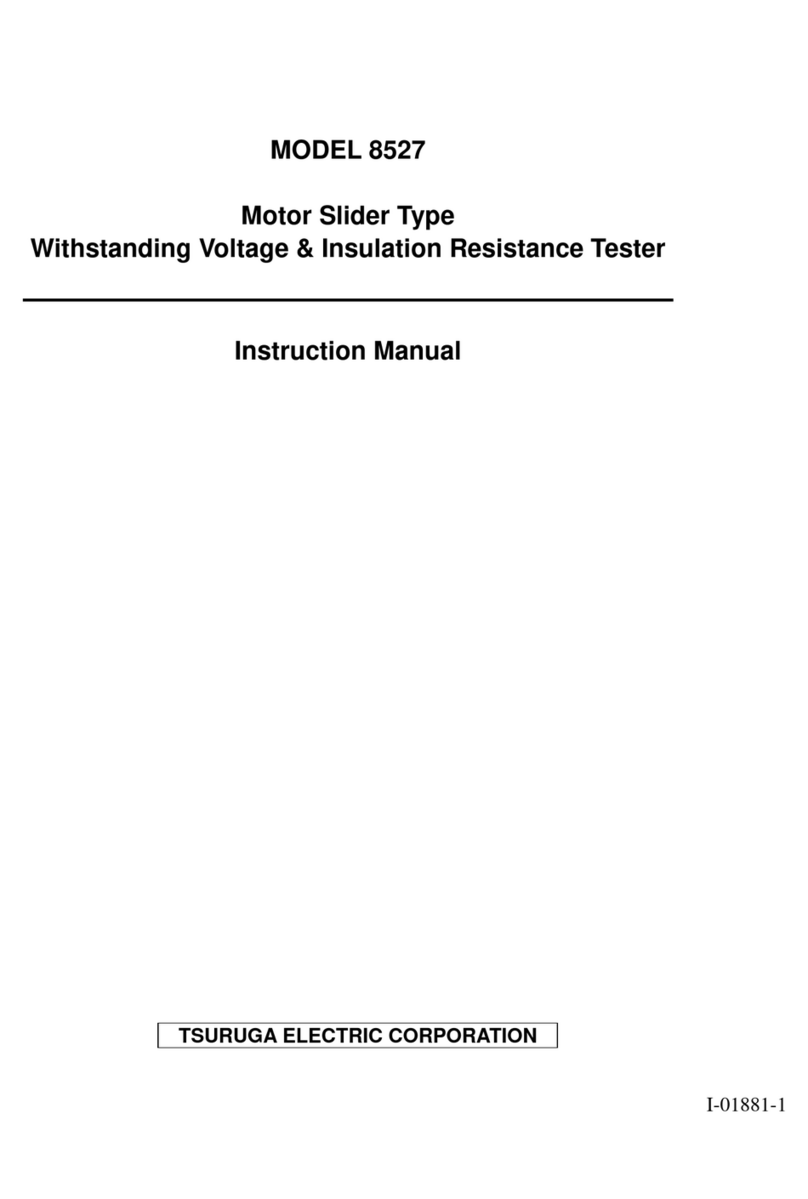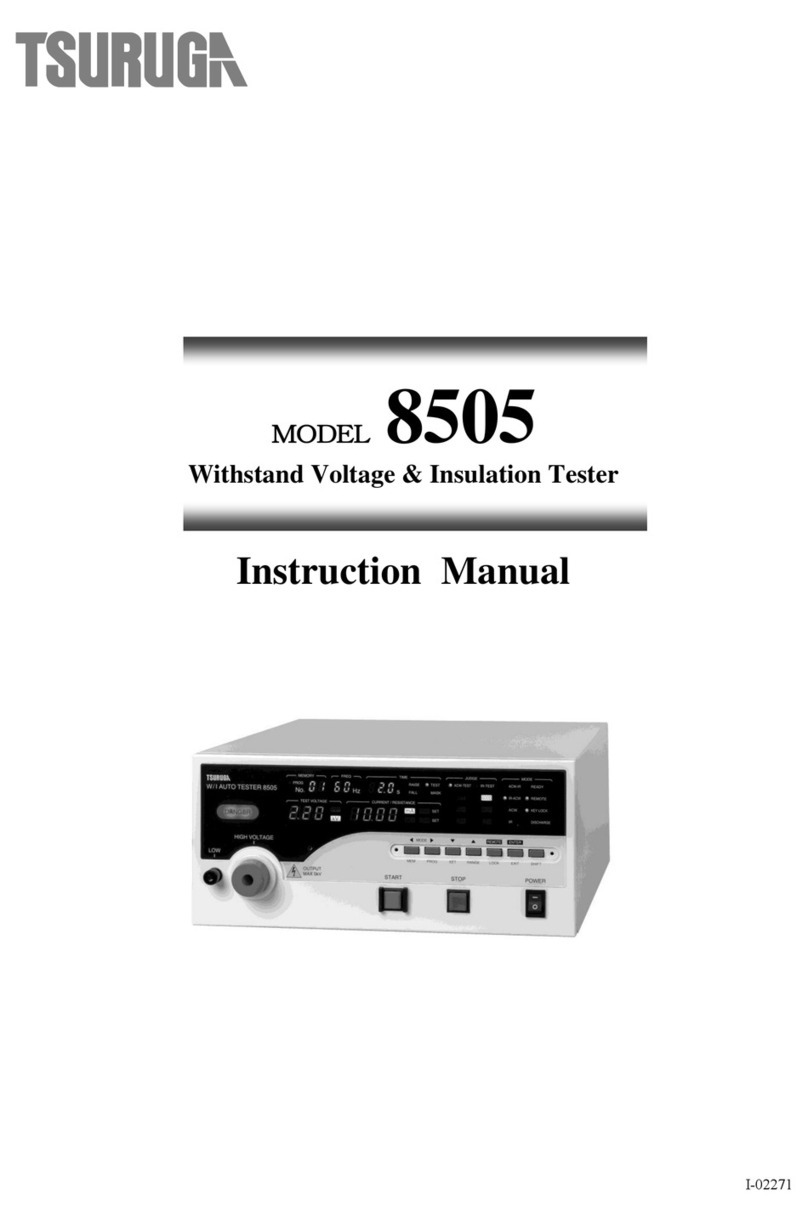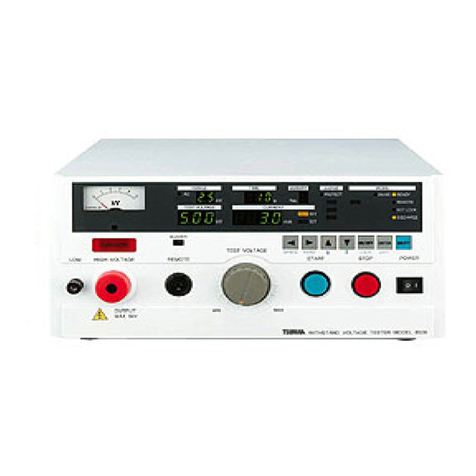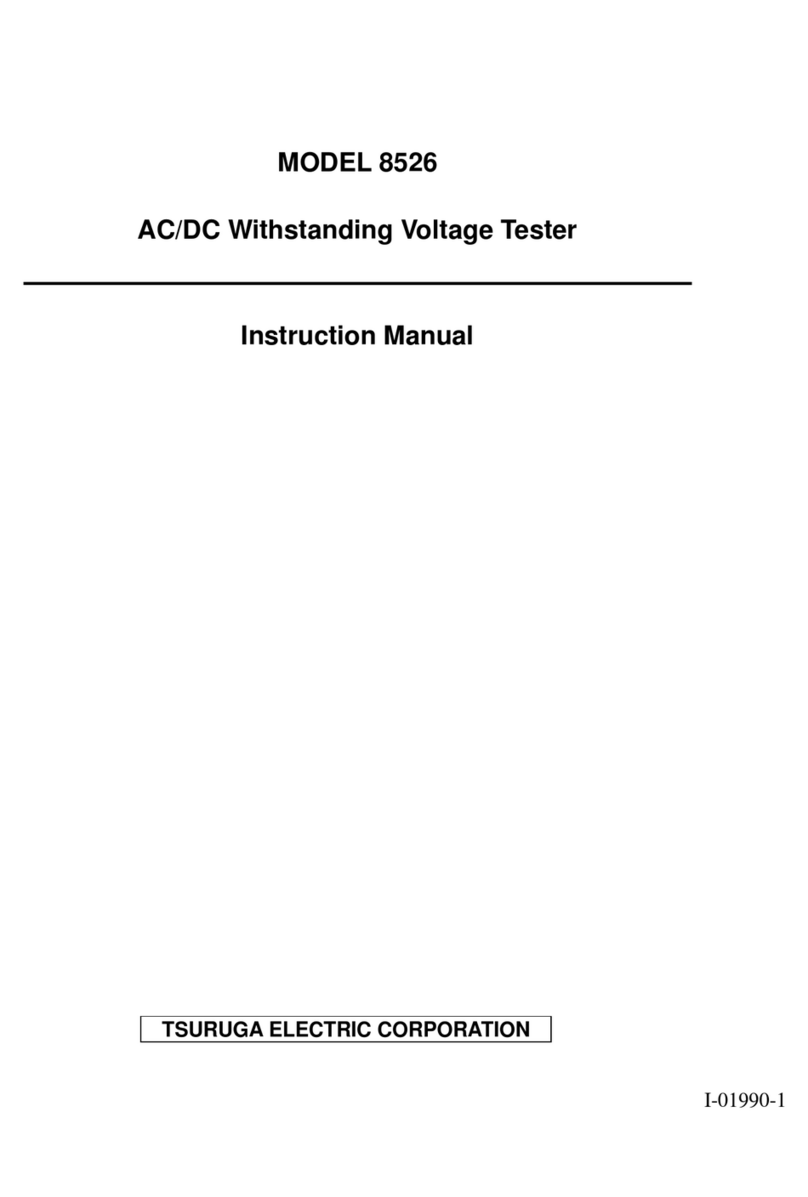Tsuruga 8507 User manual

#
MODEL 8507
AC-W HIGH SPEED TESTER
Operation Manual
I-02414

MODEL 8507
Contents
1.Preface ············································································· 1
1.1 Preparations prior to use ··························································································· 1
1.2 Confirmation prior to use ·························································································· 1
1.3 Warning and caution during measurement ··································································· 2
2.Preparation before use ······················································ 3
2.1 Connection of power code ························································································ 3
2.2 Connection of protective earth terminal ····································································· 3
2.3 Connection of the external control equipment ····························································· 3
2.4 Connection of high voltage cable ··············································································· 4
2.5 Power on and off ···································································································· 4
3.Name of parts ···································································· 5
3.1 Front panel ············································································································· 5
3.2 Rear panel ·············································································································· 6
3.3 Display panel ·········································································································· 7
4.Operation ·········································································· 8
4.1 Power supply ········································································································ 8
4.2 Setting flow ·········································································································· 8
4.2.1 MEMORY SET flow ····················································································· 9
4.2.2 GENERAL SET flow ·················································································· 10
4.2.3 SYSTEM SET flow ···················································································· 10
4.3 Key lock ············································································································· 11
4.4 Memory ············································································································· 12
4.5 Memory setting ··································································································· 13
4.5.1 Selection of memory ··············································································· 14
4.5.2 Setting of test start mode ········································································ 14
4.5.3 Setting of the test voltage ········································································ 15
4.5.4 Setting of the frequency ··········································································· 16
4.5.5 Setting of the comparator ········································································ 17
4.5.6 Setting of timer ······················································································ 18
4.6 Equipment setting ······························································································· 19
4.6.1 Start input setting ··················································································· 20
4.6.2 Selection of memory setting by REMOTE I/O ··············································· 20
4.6.3 Buzzer setting ························································································ 21
4.6.4 Communication setting ············································································ 22
4.7 System setting ···································································································· 23
4.7.1 Contrast setting ····················································································· 23

MODEL 8507
5.Testing ············································································ 24
5.1 START/STOP of testing ··························································································· 24
5.1.1 Switching operation ················································································· 24
5.1.2 REMOTE operation ·················································································· 25
5.1.3 Condition of display/output at the test end ················································· 25
6.External control ······························································ 26
6.1 Control terminal(REMOTE I/O) ············································································· 26
6.1.1 Terminal arrangement ············································································· 26
6.1.2 Input/output signal ················································································· 27
6.1.3 Memory operation ··················································································· 27
6.1.4 Internal circuit configuration ····································································· 28
6.1.5 External control timing chart ···································································· 29
7.Communication (RS-232C) ·············································· 31
7.1 Specification ········································································································· 31
7.1.1 Communication specification ······································································ 31
7.1.2 Connector pin arrangement ······································································· 31
7.1.3 Operation ······························································································· 32
7.1.4 Test result output ····················································································· 32
7.2 List of communication command and response ·························································· 33
8.Error display, etc. ···························································· 39
9.Maintenance ··································································· 40
10.Troubleshooting ····························································· 40
11.Specifications ································································ 41
11.1 Test conditions ··································································································· 41
11.2 General specification ···························································································· 43
11.3 Table of factory setting ························································································ 44
11.4 External dimensions ···························································································· 45

MODEL 8507
This page is blank.

- 1 - MODEL 8507
1.Preface
We would like to thank you for your purchase of our MODEL 8507. For safety and proper use of this product,
please carefully read this operation manual before the use.
【Feature / Characteristics】
8507 is a withstand voltage tester with maximum output 1000V and output capacity 10VA.
The setting of upper and lower limit leakage current and the function of timer enable the test result more
accurately.
8 sets of re-writable and readable memories of test conditions can be stored.
START/STOP operation can be done by external control using remote I/O connector.
Depending on measuring conditions, the test result like judgment can be obtained by open collector.
! Caution
● To avoid break-down, malfunction or deterioration of life time,
do not use this product in such places where:
◆ Exposed to rain, water drops or direct sunlight.
◆ High temperature or humidity, heavy dust or corrosive gas.
◆ Affected by external noise, radio waves or static electricity.
◆ where there is constant vibration or shock.
● Do not open the case or modify the main body.
1.1 Preparations prior to use
● Unpacking
When the tester is delivered, please check whether it conforms to the required specifications and has not
been damaged in transit. If there is any damage on the tester or it does no work in conformity with the
specifications, please inform us of the model and product name.
● Storage
In case of storing the tester for a long time, store it at the place of low humidity and where it is not
exposed to the direct sunlight.
1.2 Confirmation prior to use
● Power supply
Use the tester with the power source voltage within 90 to 250VAC and the frequency 50/60Hz.
When connecting the power supply cable, confirm that the power supply switch is turned OFF
● Power supply cable
The plug of power supply cable connected to the tester is for 100VAC use. When the tester is used with
200VAC, replace the plug with appropriate one for 200VAC use. Please connect the power supply cable to
the power supply connector on the rear panel of the tester. The plug of power supply cable has 3 pins and
the round shape pin in the center is for grounding.

MODEL 8507 - 2 -
1.3 Warning and caution during measurement
Electric shock accident or malfunction
! Warning
● Check and confirm the cable condition and metal portion of the wire before
use. There is a danger of electric shock if the measuring cable is broken or the
metal portion of the wire is exposed. If some damage is found, stop using it
immediately and replace the specified new one.
● In order to prevent the electric shock accident or the failure of this unit, do not
apply voltage to the measurement terminal.
● In order to prevent the failure, conduct the measurement after turning off the
power related to the measurement.
● A high voltage is passed through the measuring cable. Never touch the tip of
the measuring cable to avoid the electric shock.
Connection of the control cable and communication cable
! Caution
● Use the specified cable size to connect the control terminal.
● Make sure that communication cable and control cable are connected surely. If
the connection is not undertaken correctly, it may cause of the failure to satisfy
specification or malfunction.
● Power supply must be turned off on each device before connection of
communication cable and control cable. Failure to turn of the electric power
cause the electric shock or malfunction.
Other caution
! Caution
If power supply is done by UPS(Uninterruptible power supply device) or DC-AC
inverter, do not use rectangular wave or pseudo rectangular wave output of
UPS or DC-AC inverter. If used, this may cause the malfunction of the
instrument.

- 3 - MODEL 8507
2.Preparation before use
2.1 Connection of power code
1 Make sure that the power switch POWER of this tester is turned off.
2 Connect the power cord to the inlet for the power supply of the rear panel.
The plug of the power cord that comes with this tester is for AC100V. If it exceeds AC125V, use the
power cord suitable for the rating. 200V type power cord with a plug attached (European 2-pole with
earth model name 5880-23-030) is optional.
3 Power cord plug (3P) is connected to the earthed outlet.
The plug of the power cord is 3- pin and the round shaped pin of the center is the earthing.
! Warning
Use supply voltage AC100 to AC240V (AC90 to 250V) and power frequency
50/60Hz. Besides, when you connect the power cord, make sure that the power
switch is turned off. Beyond this range could lead to the failure and incomplete
operation of the tester.
2.2 Connection of protective earth terminal
Earth the protective earth terminal ⑨ to the ground using the supplied earthing wire. When the earthing
is imperfect or when the output is short circuited to the ground or power line, the case of the tester is
highly charged and it is dangerous to touch it. Besides, when using the tester, be sure to check that the
earthing wire is not disconnected.
! Warning
If the earthing is imperfect, there is a risk of an electric shock.
2.3 Connection of the external control equipment
External control equipment can be connected to the remote I/O connector ⑩
Ref. to “6. External control” for information about connection method.

MODEL 8507 - 4 -
2.4 Connection of high voltage cable
During the test, the high voltage output terminal is charged to a high voltage. Connect the supplied high
voltage cable with the HIGH VOLTAGE terminal and LOW terminal. For high voltage cable, use the
supplied cable or cable adaptable for the voltage used.
! Warning
Make sure to confirm the power off before connecting the high voltage cable.
There is a risk of an electrical shock.
! Warning
When the low voltage side cable is disconnected, the whole tested equipment
gets charged with high voltage and there is a risk of an electric shock.
2.5 Power on and off
After purchasing for the first time when POWER switch⑮ is on, the test begins and due to interlock
function, the state becomes PROTECTION state. Connect the supplied remote I/O connector.
Use the supplied remote I/O connector only after the PROTECT state is released easily.
If you do the actual test, use the interlock function for the safety.
To guard the test area against the electric shock, use the interlock function like cut-off etc.
when opening the door or cover.
1 Make sure that the power cord, connection cables etc. are connected properly.
2 Press “-” side of POWER switch ⑬of rear panel to turn it on.
3 After turning on the power switch, all lights on display are on for few seconds (lamp test).
However, TEST VOLTAGE and CURRENT/RESISTANCE display firm version.
After a few seconds, the display would be of test mode when the previous power was turned off.
4 Press “○” side of the POWER switch of the rear panel to turn it off.

- 5 - MODEL 8507
3.Name of parts
3.1 Front panel
① Display panel This is green graphic display.
It displays the test results and various settings, etc.
② TEST lamp Test lamp lights up during test.
③ Judgment lamp HIGT︓Red lamp is lit up when the measured current value exceeds the high limit
value.
GOOD︓Yellowish green lamp is lit up with a good judgment.
LOW︓Red lamp is lit up when the measured current value is below the low limit
value.
④
Function key
F1 to F4 these keys are used to set various test conditions and comparators.
⑤ START switch Switch to start the test during manual mode.
⑥ STOP switch Switch to stop the test when test is undergoing.
It clears all waiting judgment.
[ SET ] [ ] [ LOCK ]
12.34
TIMER
1000V
F3F2F1
HI SET
LO SET
TEST
[RCL]
F4
56
No.1 60Hz Ready
mA
15.00
OFF
mA
1000V
01.0s
OUTPUT
MODEL 8507
HIGH
GOOD
LOW
3
AC-W HIGH SPEED TESTER
4
1 2
mA

MODEL 8507 - 6 -
3.2 Rear panel
⑦ HIGH VOLTAGE terminal High voltage terminal where output of High voltage is obtained during test.
⑧ LOW terminal Low voltage terminal where the electric potential same main case is
obtained during test.
⑨ Protective earthing terminal A terminal for earthing to ground having the same electric potential with
main case.
⑩ REMOTE I/O connector Connector for external control.
⑪ RS-232C connector Connector for RS-232C communication.
⑫ Power inlet Connect the supplied power supply cord. Use the power supply voltage and
frequency within the specified range.
⑬ Power supply switch Power supply ON/OFF switch.
HIGH VOLTAGE
OUTPUT
MAX 1kV
LOW
注意
EARTH TERMINAL.
ENSURE GROUNDING OF
接地端子は確実に
大地アースしてください。
CAUTION
7
8
910 11
ON OFF
AC LINE 65VA MAX
12
13
100-240V 50-60Hz
RS-232CREMOTE I/O

- 7 - MODEL 8507
3.3 Display panel
⑭Memory No. Displays memory No. (No.1 to No.8)
⑮Test voltage Displays the test voltage setting. (10V to 1100V)
⑯Frequency of the tested voltage
Displays the set frequency value of the tested voltage.
⑰Status Display the status of 8507.
Standby state ︓Ready
Under test ︓RUN
During Interlock (Open)︓LOCK
REMOTE setting REMOTE ︓ R
MEM.CTL setting REMOTE︓ M
ONLINE ON setting ︓
⑱Measured value Display the measured value of leak current.
This model displays Peak value. (Not effective value)
⑲Comparator Displays the set value of HIGH and LOW comparator.
⑳Function Displays the function guide of F1 to F4.
F4 displays the status of key lock.
Key lock ON/OFF can be done by press for more than 3 s. Reverse display is
shown during key lock condition.
1000V
TIMER
12.34
HI SET
LO SET
No.3 60Hz
[LOCK][][SET] [RCL]
mA
mA
mA
15.00
OFF
OUTPUT
1000V
1.0 s
14 15 16 17
18
19
20
RReady M

MODEL 8507 - 8 -
4.Operation
4.1 Power supply
First confirm the power OFF of the switch located at the rear panel of the instrument and connect cord
to the power supply. Then, ON the power supply switch. Which enables to operate immediately but it
is preferred for preheating 30 minutes before the use.
As this model is equipped with a parameter holding function, following status can be memorized even
though the power supply is turned OFF.
(1) 8 sets of memories (Test voltage, Frequency, Comparator setting, Timer etc.)
(2) Key lock state
(3) Start input setting (REMOTE/MANUAL)
(4) Various types of setting
4.2 Setting flow
SYSTEM SET F4[ENT]
GENERAL SET F4[ENT]
MEMORY SET
F4[LOCK]
F1[SET]
F4[ENT]
F2[RCL]
F1[SEL]
F1[SEL]
F1[SEL]
4.2.1 Refer to MEMORY SET flow
4.2.2 Refer to GENERAL SET flow
4.2.3 Refer to SYSTEM SET flow
SETTING MODE
Setting screen
Invalid key operation from F1 to F3
Memory selection from No.1 to 8
Test screen flow
Test results screen Initial screen after power on (Standby)
[]
SETTING MODE
SYSTEM SET
[ ENT ]
MEMORY SET
[ RCL ][SEL]
GENERAL SET
-
ON OFF

- 9 - MODEL 8507
4.2.1 MEMORY SET flow
MEMORY No 1
TEST MODE
VOLTAGE 1000V
F4[ENT]
F4[ENT]
HIGH SET
LOW SET
AUTO CLR
50Hz
15.00mA
OFF
TIMER 0050 c
01.0 s
FREQ
MEMORY SET 2/2
MEMORY SET 1/2
Function
Function
Contents
Contents
Memorize and return to
F2[▲]、F3[▼] Switching between contents
Note:When FREQ is selected, if F1[SEL] key is
pressed, the screen is switched
to 2/2 of the MEMORY SET.
Memorize and return to
F2[▲]、F3[▼] Switching between contents
pressed, the screen is switched
to 1/2 of the MEMORY SET.
Standby screen
Note:When TIMER is selected, if F1[SEL] key is
standby screen
standby screen
F1[SEL] Select of function (Downward only)
F1[SEL] Select of function (Downward only)

MODEL 8507 - 10 -
4.2.2 GENERAL SET flow
4.2.3 SYSTEM SET flow
F4[ENT]
F4[ENT]
F4[ENT]
REMOTE MANUAL
OFF
ONLINE
RS BPS 19200BPS
RS PRITY NONE
GENERAL SET 1/3
GENERAL SET 2/3
GENERAL SET 3/3
BUZZ MODE OFF
BUZZ VOL 3
MEM,CTRL
ON
Standby screen
Function Contents
Function Contents
Function Contents
Memorize and return to
F2[▲]、F3[▼] Switching between contents
Note:When MEM.CTRL is selected,
if F1[SEL] is pressed, the screen is
switched to 2/3 of the GENERAL SET.
Memorize and return to
F2[▲]、F3[▼] Switching between contents
if F1[SEL] is pressed, the screen is
Note:When BUZZ VOL is selected,
switched to 3/3 of the GENERAL SET.
Memorize and return to
F2[▲]、F3[▼] Switching between contents
if F1[SEL] is pressed, the screen is
Note:When RS PRITY is selected,
switched to 1/3 of the GENERAL SET.
standby screen
standby screen
standby screen
F1[SEL] Select of function (Downward only)
F1[SEL] Select of function (Downward only)
F1[SEL] Select of function (Downward only)
F4[ENT]
SYSTEM SET
3CONTRAST
Standby screen
Function Contents
Memorize and return to
F2[▲]、F3[▼] Switching between contents
standby screen

- 11 - MODEL 8507
4.3 Key lock
It is a switch that prohibits operation of the instrument from the front panel in order to avoid the
measurement by unintentional change of setting. But, key lock can’t be set in START switch, STOP
switch. Display of the LOCK back ground changes during key lock condition. If other key are required
to use during key lock condition, key lock must be released first to use the other keys.
●Key lock method
Press F4 [LOCK] key for more than 3 s.
Display of the back ground of LOCK changes which shows that instrument is in locked condition.
●Cancellation of key lock
During the key in locked condition, press F4 [LOCK] key for more than 3 s.
Key lock will be released.
HIGH
GOOD
LOW
F3F2F1
LOCK
TEST
F4
MODEL 8507
AC-W HIGH SPEED TESTER
[SET] [ ]
12.34
TIMER
1000V
HI SET
LO SET
[RCL]
No. 1 60Hz Ready
mA
15.00
OFF
mA
1000V01.0s
OUTPUT
mA

MODEL 8507 - 12 -
4.4 Memory
This model is equipped with 8 sets of memories that store comparator and test conditions. The
following items are available for memory storage.
・Starting test start mode(AUTO CLR、MANUAL CLR)
・Setting of the test voltage
・Setting of the frequency
・Setting of the comparator(Upper and Lower value)
・Setting of timer
[Selection of memory]
●Front panel method
Call
When F2 [RCL] key is pressed in standby state, memory No. will increased and setting call will be
displayed.
Memory from no. 1 to no. 8 can be selected.
●External control method
Refer to memory operation (6.1.3) for detail information.
[Memory registration]
After selecting the memory No. you want to register, select test mode, test voltage, frequency,
comparator and timer with MEMORY SET.
HIGH
GOOD
LOW
F3F2F1 F4
[ SET ] [ ] [ LOCK ]
12.34
TIMER
1000V
HI SET
LO SET
TEST
[RCL]
No.1 60Hz Ready
mA
15.00
OFF
mA
1000V01.0s
OUTPUT
MODEL 8507
AC-W HIGH SPEED TESTER
mA

- 13 - MODEL 8507
4.5 Memory setting
Input of MEMORY SET
① Press F1 [SET] key in standby state.
Display changes to SETTING MODE.
② Press F1 [SEL] key to select MEMORY SET.
Memory setting can be changed by pressing F4 [ENT] key.
Basic operation
Memory No., test start mode, test voltage, frequency, comparator and timer can be set.
Operation key
F1 [SEL] ︓Selection of setting item.
The back ground of the display color of the selected item will be changed.
F2 [▲] ︓Change of setting values
F3 [▼] ︓Selection of setting from TEST MODE , FREQ setting value can be increased
or decreased by numerical setting.
F4 [ENT] ︓Memorize the setting and the display returns to standby state.
HIGH
GOOD
LOW
[]
F3F2F1
SETTING MODE
SYSTEM SET
[ENT]
MEMORY SET
TEST
[RCL][SEL]
F4
GENERAL SET
MODEL 8507
AC-W HIGH SPEED TESTER
HIGH
GOOD
LOW
F3F2F1 F4
TEST
MODEL 8507
AC-W HIGH SPEED TESTER
[ENT]
MEMORY SET
MEMORY No
TEST MODE
VOLTAGE 1000V
[][]
1
[SEL]
1/2
AUTO CLR
FREQ 50Hz

MODEL 8507 - 14 -
4.5.1 Selection of memory
① Press F1 [SEL] key to select the MEMORY No.
② Select the Memory No. by F2 [▲], F3 [▼] key.
③ Press F4 [ENT] to memorize the setting and the display returns to standby state.
To continue the other setting, select the items that you want to change by pressing F1 [SEL]key
4.5.2 Setting of test start mode
Select the test start mode, MANUAL CLR mode or AUTO CLR mode.
・At MANUAL CLR mode, when the judgment is ‘HIG’H or ‘LOW’, the start can’t be started by pressing
‘START’. Once clear the judgment by pressing ‘STOP’, ‘START’ can be active.
・At AUTO CLR mode, by pressing ‘START’, the test can be started, regardless of judgment.
① Press F1 [SEL] key to select the MEMEORY SET and press F4 [ENT] key to enter it.
Select TEST MODE by F1 [SEL] key.
② Press F2 [▲], F3 [▼] key to select MANUAL CLR/AUTO CLR.
③ Press F4 [ENT]key to memorize the setting and the display returns to standby state.
To continue the other setting, select the items that you want to change by pressing F1 [SEL]key
HIGH
GOOD
LOW
F3F2F1
[ENT]
MEMORY SET
MEMORY No
TEST MODE
VOLTAGE
1
1000V
[][]
TEST
[SEL]
F4
MODEL 8507
AC-W HIGH SPEED TESTER
FREQ 50Hz
AUTO CLR
1/2
HIGH
GOOD
LOW
F3F2F1
[ENT]
MEMORY SET
MEMORY No
TEST MODE
VOLTAGE 1000V
[][]
1
TEST
[SEL]
F4
1/2
MODEL 8507
AC-W HIGH SPEED TESTER
FREQ 50Hz
AUTO CLR

- 15 - MODEL 8507
4.5.3 Setting of the test voltage
① Press F1 [SEL]key to select MEMEORY SET and press F4 [ENT]key to enter it.
Select VOLTAGE by F1 [SEL] key.
② Press F2 [▲], F3 [▼] key. to change the setting
If keys are kept pressed, the value is changed continuously.
Setting range 0V to 1100V (Resolution 10V)
③ Press F4 [ENT]key to memorize the setting and the display returns to standby state.
To set other values, select the item by pressing F1[SEL]key
HIGH
GOOD
LOW
F3F2F1
[ENT]
MEMORY SET
MEMORY No
TEST MODE
VOLTAGE
1
[][]
1000V
TEST
[SEL]
F4
MODEL 8507
AC-W HIGH SPEED TESTER
FREQ 50Hz
AUTO CLR
1/2

MODEL 8507 - 16 -
4.5.4 Setting of the frequency
① Press F1 [SEL] key to select MEMORY SET by and press F4 [ENT] key to enter it.
Select FREQ by F1 [SEL] key.
② Press F2 [▲], F3 [▼] key to select 50Hz or 60Hz.
③ Press F4 [ENT]key to memorize the setting and the display returns to standby state.
To continue the other setting, select the items that you want to change by pressing F1 [SEL]key.
Note:
When the frequency is changed, the cycle timer is recalculated in order to keep test time unchanged.
Recalculation is done in case the setting test time is more than 1.0s.
During 50 cycles at 50Hz (1.0s.), if 60Hz is set, it becomes 60 cycles (1.0s.).
Calculation error may occur when frequency setting is changed many times. Make sure that the timer
setting is accurate when frequency setting is changed.
HIGH
GOOD
LOW
F3F2F1
[ENT]
MEMORY SET
MEMORY No
TEST MODE
VOLTAGE
1
[][]
TEST
[SEL]
F4
1/2
FREQ
1000V
60Hz
AUTO CLR
MODEL 8507
AC-W HIGH SPEED TESTER
Table of contents
Other Tsuruga Test Equipment manuals
Popular Test Equipment manuals by other brands

Redtech
Redtech TRAILERteck T05 user manual

Venmar
Venmar AVS Constructo 1.0 HRV user guide

Test Instrument Solutions
Test Instrument Solutions SafetyPAT operating manual

Hanna Instruments
Hanna Instruments HI 38078 instruction manual

Kistler
Kistler 5495C Series instruction manual

Waygate Technologies
Waygate Technologies DM5E Basic quick start guide

StoneL
StoneL DeviceNet CK464002A manual

Seica
Seica RAPID 220 Site preparation guide

Kingfisher
Kingfisher KI7400 Series Training manual

Kurth Electronic
Kurth Electronic CCTS-03 operating manual

SMART
SMART KANAAD SBT XTREME 3G Series user manual

Agilent Technologies
Agilent Technologies BERT Serial Getting started











